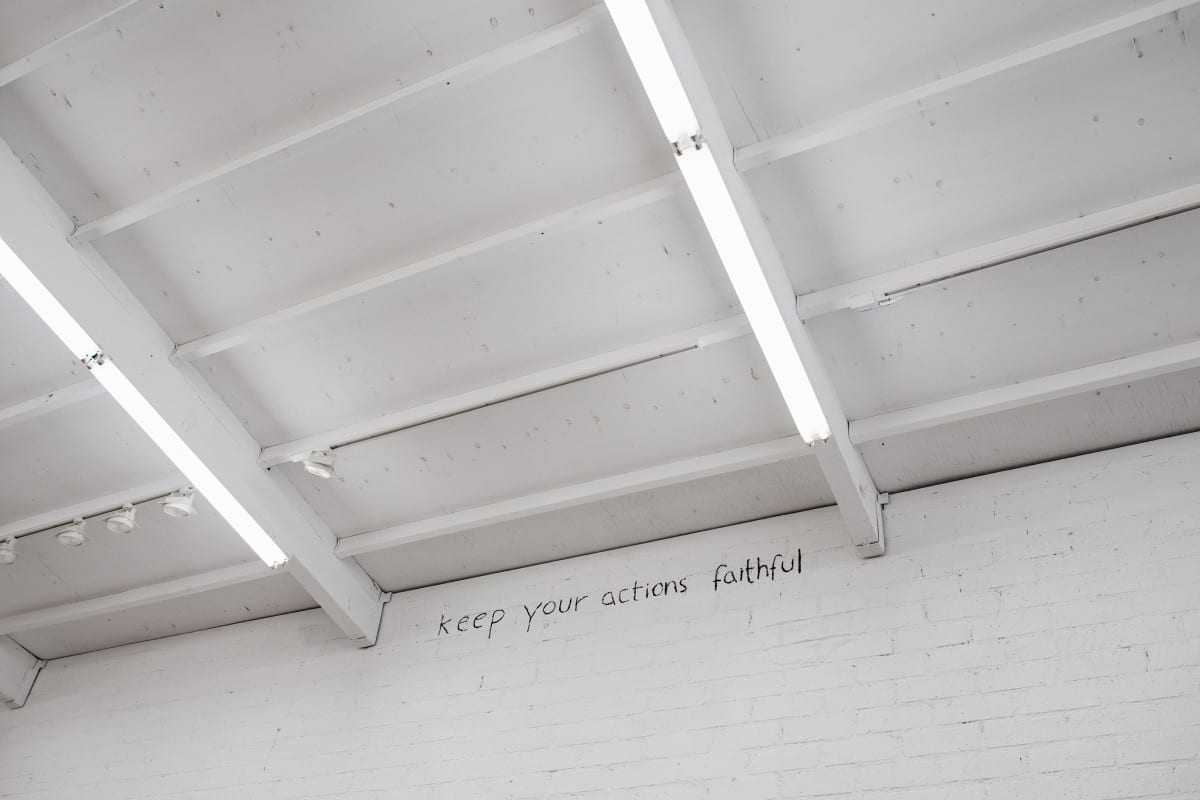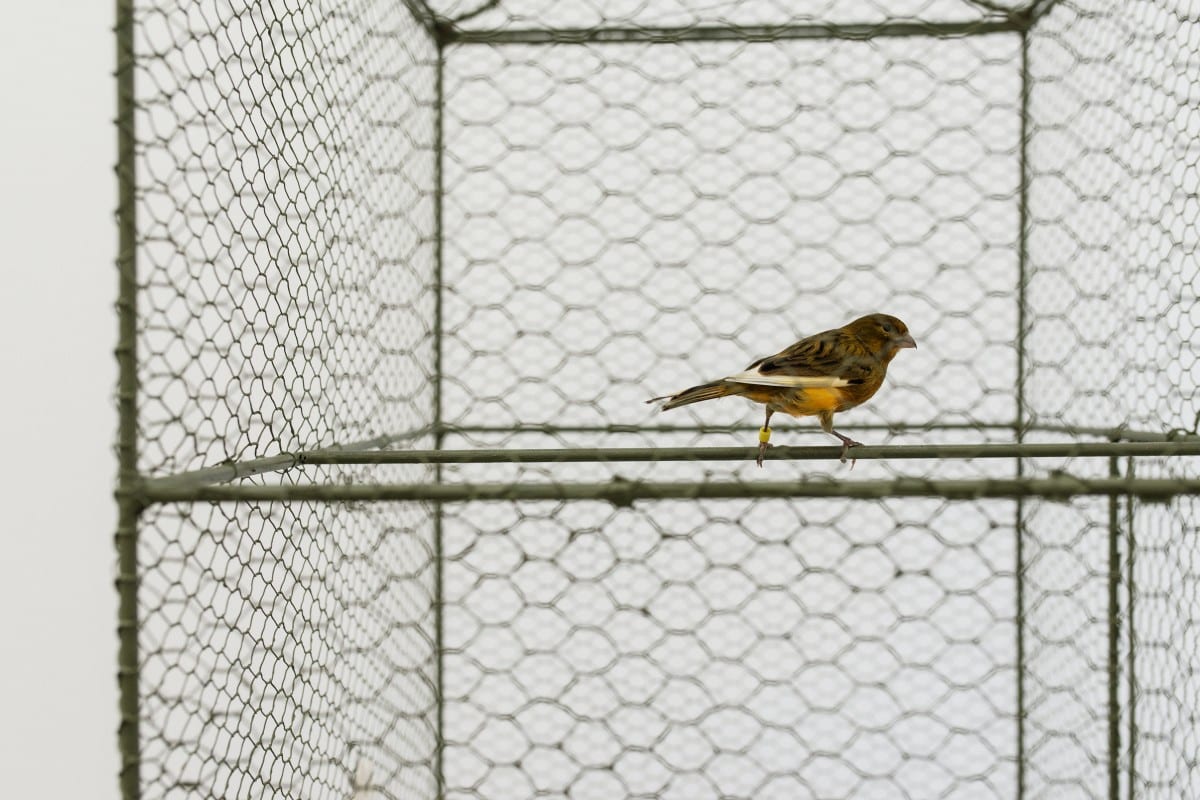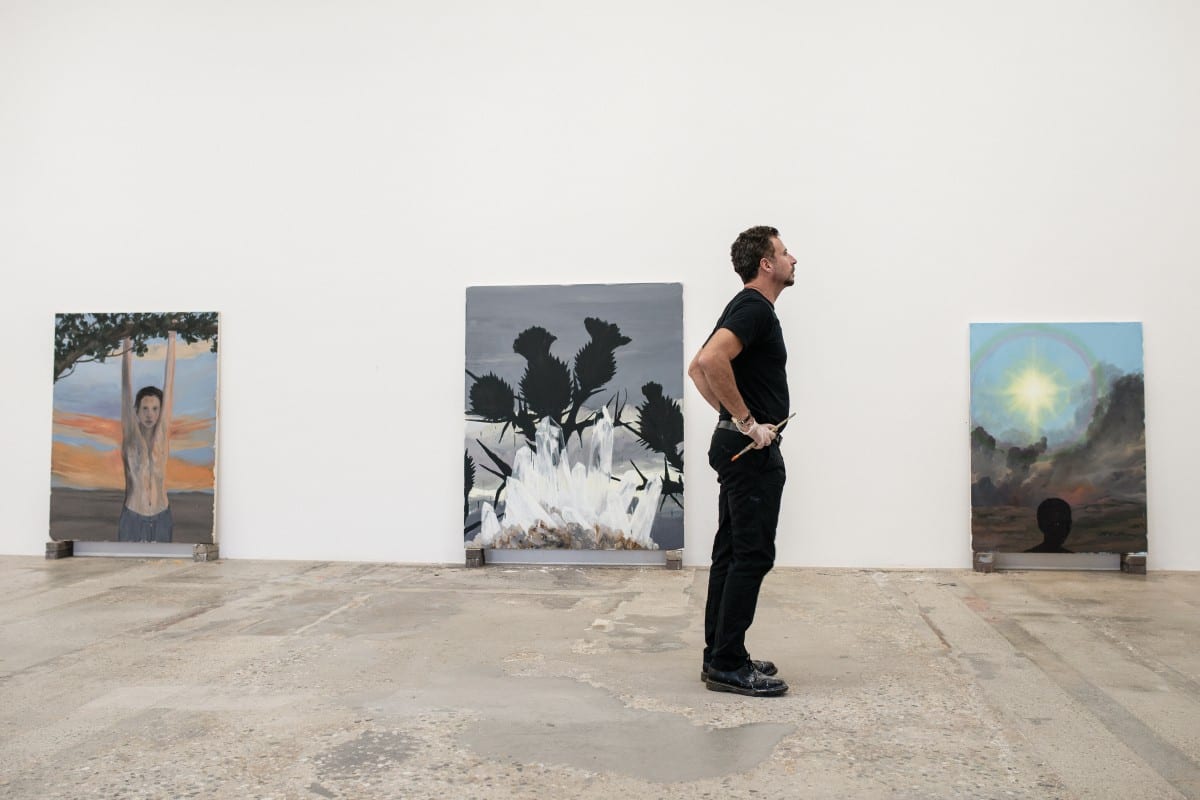Nestled inside an industrial complex off a beaten path in Culver City, adjacent to lush sprawling grills hills of a cemetery lined with flowers from visiting loved ones, lies a sanctuary of artistic solace. A modest black plaque rests on the exterior brick wall with a crest bearing the profile of a whale rising above the surface of the ocean, while stars shine in the sky above. A single line beneath the signage reads “Studio Martinez Celaya.” Once inside the space the cacophony of traffic, rush hour, and time is suspended and immediately forgotten. Books with faded dust jackets spanning decades and subject matter are catalogued and displayed behind glass and kept under lock and key. Often droning electronic music echoes off the cement floors and reverberates through the intricate space, making the studio feel like a living, breathing organism. After ten years in Miami, Enrique Martínez Celaya has returned to Los Angeles and has designed a studio space that rivals many galleries and houses work that spans his entire career to date. Systematically catalogued artworks documented with lined index cards demonstrate the breadth and depth of Celaya’s practice. A pastel dated from 1977, when the artist was only thirteen years old is positioned next to another landscape created in 2009. Growing up as an apprentice to a painter, Celaya was advised to keep at least one piece of work for every series he created. Standing in the first viewing space, there is a palpable energy, whispers of an ongoing conversation between the works of the past and the present.

Moving further around the studio, one can’t help but feel an overwhelming sense of order. The space is nearly spotless. If there is an emptiness on any wall it is temporarily filled with a rough rendering drawn on paper, indicating that a painting is in the process of being created. Cans of paint stained in suspended animation are deliberately aligned along the episode brick walls next to a tidy work station organized with brushes and palettes. Trained as a physicist as well an artist, Celaya is able to use both sides of his brain with equal rigor and imagination. He studied Applied & Engineering Physics at Cornell University and Quantum Electronics at the University of California, Berkeley. He then attended the Skowhegan School of Painting & Sculpture, and earned a Master of Fine Arts with the department’s highest distinction from the University of California, Santa Barbara. Celaya conducts his studio with a strict worth ethic similar to a scientific lab. His laboratory is an incubator of prose, where his own writing, avid reading and decades of renderings on paper, watercolor and canvases come together to form a beautiful equation. I wait for the artist to arrive while seated on a couch in an area adjacent to the large painting area. The faint chirping of birds echoes from a nearby vintage birdcage. If only those birds could speak- as they get to witness Celaya day in and day out attending to his paintings with unwavering commitment.


What role does language play in the development of your work?
In general I go back to Literature and Philosophy to sort out the nature of the questions I’m really asking, and then I go to my own writings. I’m thinking a lot about the relation between poetry and my work which has always existed and people have remarked on it, but I am more interested in taking it a step further than I have in the past. I’m not exactly sure what that means so I have been looking very attentively at a couple of poems that have interested me for a long time. I have also looked at Chinese and Japanese calligraphy and the relation between text and images. I have kept text in the paintings that I have done and sometimes that will appear in the work but always sort of on the side of the work.
I had the opportunity to view The Portrait Project that depict philosophers, poets, artists, musicians, writers and family members that have been influential to your artistic development. Is that a project that you hope to continue working on?
It is. Originally when I first did it years back I never thought it would be something I would ever show because I did it for myself as companion pieces. I would rip my own watercolors, glue them back together and draw on that. The reason I was using my own watercolors was a pre-investment in the material itself. Now I would like to see them installed in their totality because they have a very specific feeling seeing them all together but I feel like I still have so much more to do with them, there are many people I want to have represented there. Many people who are important to me haven’t made it to those portraits so I imagine it as an ongoing project, it may take forever.
I was struck by the fact that you are so heavily invested in writing and scientific theories. In what ways has the scientific method shaped your evolution as an artist?
When you go to a lab, you go there looking for truth and there are always other politics of Science, but essentially always looking for some sort of truth. You go there regardless of what is the interest of the larger community as you go there to do your experiment and seek better understanding of life. And I think that remains the reason why I come to the studio just like when I went to the lab. Whatever I am doing is ultimately directed towards a better understanding of things rather than producing for market so that’s one legacy of art. I sort of go to somewhat of a systematic process and it doesn’t mean that determines the outcome but it does mean that there is a need to sort of look at the material that I already have and go through a rigorous process of elimination of what is not important and I think all of that is quite similar to what I did as a scientist. Maybe the materials are a little different but the process is not that different.
You had mentioned looking at calligraphy and that writing is hidden beneath your paintings. What does the writing look like?
They are written as if they were written on a piece of paper, just bigger. The reason I have been looking at these texts on Chinese paintings is because the relationship between text and images is inseparable in a way that is not obvious in Western works. I feel that this relationship is very effective in these traditions in which its hard to know where the images end and writings begins, so I have been thinking about that just for my own understanding of how to compose these images. A lot of my work always has writing behind it and then painted over it so all of these have writing behind them. For instance with the Defender you will see there’s a whole line of writing there where everything has been edited except “defender.”
It’s quite rare to meet an artist who is just as engaged with writing and analytical thinking. There is a balance between your writing and art practice because the writing is hidden behind the painting. Was the writing always there?
When I was a boy, my family had gone through all kinds of complexities and the way I dealt with that was through drawing, painting and writing not knowing that these were fields already pre-existing. My uncles were medical doctors but there was no sense of culture in my family that directed me to great examples of writing and painting. When I was a little boy I was given Tolstoy’s short stories for children and it was illustrated. I did not understand that it was literature, I’m just reading these stories and looking at the illustrations and thinking this is the world. When it was my turn to do something I found words to be beautiful and wonderful things. When I was a teenager I wanted to be a writer, I wanted to be a scientist, I wanted to be an artist but I couldn’t collapse that, all of them were interesting to me. I ended up becoming a scientist primarily because it seemed the right choice to make as a career but I kept writing, reading and painting just as much. Now today, most of the people who I look to and many of my friends are writers more than visual artists. I feel that it’s time to bring the writing out from where it is in my head. I have all this relation to writing and I feel like it should exist in a more palpable way. But there’s more to this story in my head than I have acknowledged. I have never known my mind where there have not been writing signs and art.

With the opening of Lone Star it marks your return to Los Angeles after living in Miami for ten years. Do you feel like your return has influenced the direction of your work?
I left LA ten years ago feeling like I needed to be away for a while and now being back feels equally right. LA hasn’t changed the direction of my work yet but I suspect it will. It’s not so much because of LA but my own shift, returning back to this landscape. It’s sort of a coming of age soft of speak, it sounds silly considering I am 50. It feels like the evolution process of this way of being that I have been investigating for the last 20 years is here now and I feel like this is the moment. So it’s almost like the move back to LA is representative of the moment like I am in my head. And being back here is an important part of that moment, so the work that I will show will be something different and I think it’s because I am different than I was.
All images photographed by Rainer Hosch ©Installation Magazine
